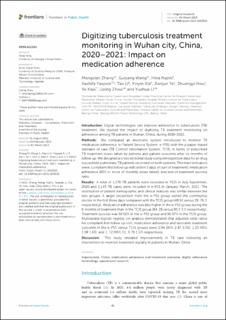| dc.contributor.author | Zhang, Mengxian | |
| dc.contributor.author | Wang, Guiyang | |
| dc.contributor.author | Najmi, Hina | |
| dc.contributor.author | Yaqoob, Aashifa | |
| dc.contributor.author | Li, Tao | |
| dc.contributor.author | Xia, Yinyin | |
| dc.contributor.author | Ye, Jianjun | |
| dc.contributor.author | Hou, Shuangyi | |
| dc.contributor.author | Xiao, Ye | |
| dc.contributor.author | Zhou, Linping | |
| dc.contributor.author | Li, Yuehua | |
| dc.date.accessioned | 2023-05-26T08:06:27Z | |
| dc.date.available | 2023-05-26T08:06:27Z | |
| dc.date.created | 2023-03-30T11:08:53Z | |
| dc.date.issued | 2023-03-01 | |
| dc.identifier.issn | 2296-2565 | |
| dc.identifier.uri | https://hdl.handle.net/11250/3069104 | |
| dc.description.abstract | Introduction: Digital technologies can improve adherence to tuberculosis (TB) treatment. We studied the impact of digitizing TB treatment monitoring on adherence among TB patients in Wuhan, China, during 2020-2021.
Methods: We compared an electronic system introduced to monitor TB medication adherence (e-Patient Service System; e-PSS) with the p paper-based standard of care (TB Control Information System; TCIS) in terms of prescribed TB treatment doses taken by patients and patient outcome after six months of follow up. We designed a cross sectional study using retrospective data for all drug susceptible pulmonary TB patients recorded on both systems. The main indicators were: compliant first follow up visit (within 3 days of start of treatment); medication adherence (80% or more of monthly doses taken); and end of treatment success ratio.
Results: A total of 1,576 TB patients were recorded in TCIS in July September, 2020 and 1,145 TB cases were included in e-PSS in January March, 2021. The distribution of patient demographic and clinical features was similar between the two groups. A larger proportion from the e-PSS group visited the community doctor in the first three days compared with the TCIS group (48.91 versus 29. 76 % respectively). Medication adherence was also higher in the e-PSS group during the 6 months of treatment than in the TCIS group (84. 28 versus 80.3 3 % respectively). Treatment success was 92.52% in the e-PSS group and 92.07% in the TCIS group. Multivariate logistic regress ion analysis demonstrated that adjusted odds ratios for compliant first follow up visit, medication adherence and favorable treatment outcome in the e-PSS versus TCIS groups were 2.94 (95% 2.47 3.50), 1.33 (95% 1.08 1.63), and 1. 12 (95% CL: 0.79 1.57) respectively.
Discussion: This study revealed improvements in TB care following an intervention to monitor treatment digitally in patients in Wuhan, China. | en_US |
| dc.language.iso | eng | en_US |
| dc.publisher | Frontiers | en_US |
| dc.rights | Navngivelse 4.0 Internasjonal | * |
| dc.rights.uri | http://creativecommons.org/licenses/by/4.0/deed.no | * |
| dc.title | Digitizing tuberculosis treatment monitoring in Wuhan city, China, 2020–2021: Impact on medication adherence | en_US |
| dc.type | Journal article | en_US |
| dc.type | Peer reviewed | en_US |
| dc.description.version | publishedVersion | en_US |
| dc.rights.holder | Copyright 2023 the authors | en_US |
| dc.source.articlenumber | 1033532 | en_US |
| cristin.ispublished | true | |
| cristin.fulltext | original | |
| cristin.qualitycode | 1 | |
| dc.identifier.doi | 10.3389/fpubh.2023.1033532 | |
| dc.identifier.cristin | 2138432 | |
| dc.source.journal | Frontiers in Public Health | en_US |
| dc.identifier.citation | Frontiers in Public Health. 2023, 11, 1033532. | en_US |
| dc.source.volume | 11 | en_US |

